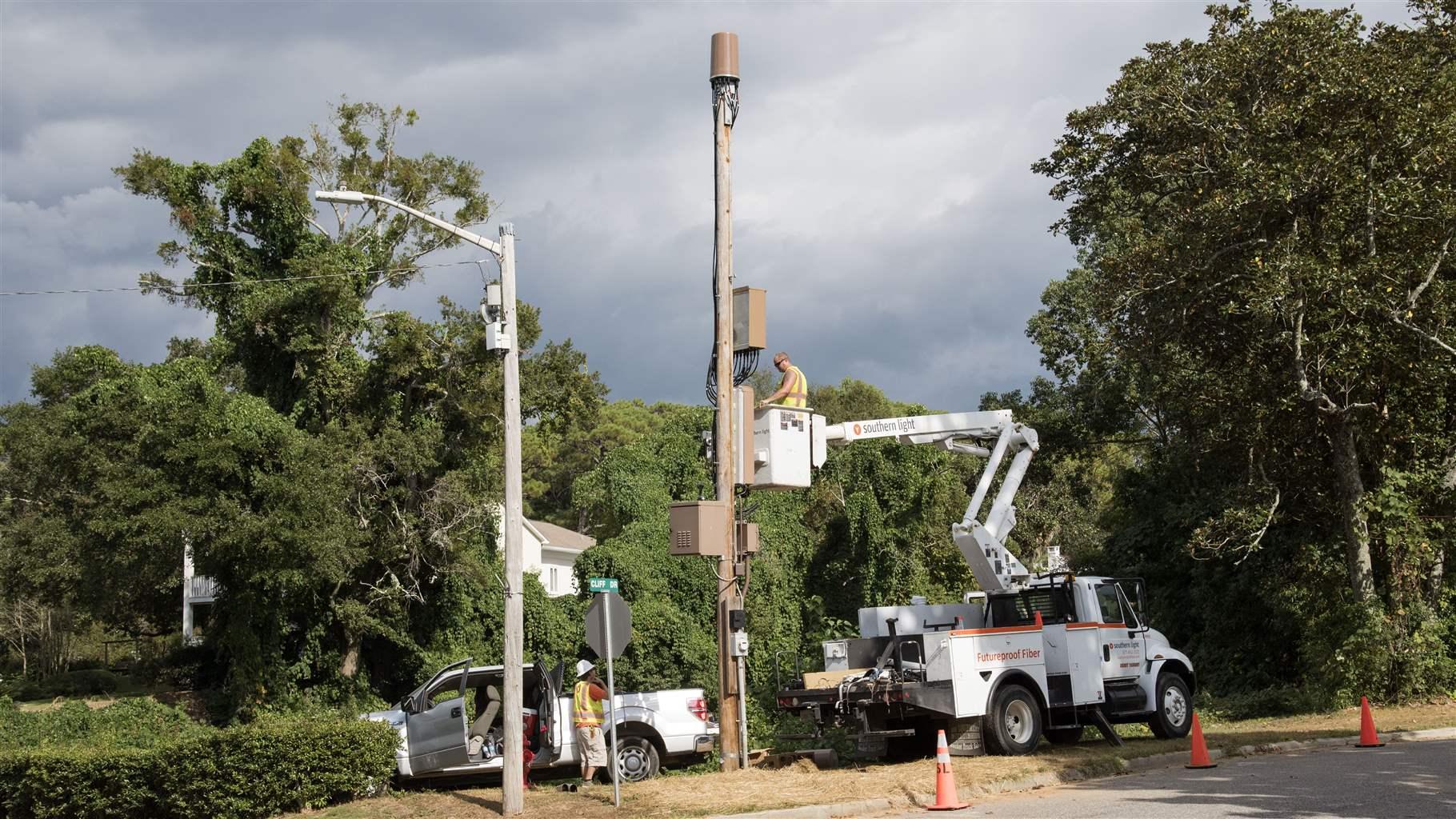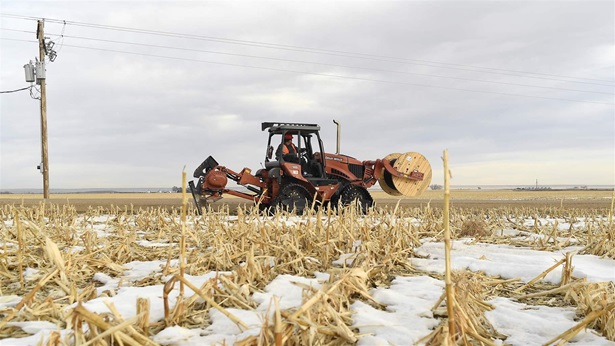Strategies for Crafting Effective State Broadband Plans
How states can capitalize on funding, other opportunities and expand high-speed internet access

Overview
States have made significant strides toward improving the availability and affordability of broadband service in recent years.1 A key step in many of those efforts has been the development of formal, statewide broadband expansion plans, often at the behest of the state legislature or as a strategic component of the state’s broadband program, that use data and stakeholder input to identify and refine goals, recommend activities, and detail implementation strategies.2
In its 2020 report, “How States Are Expanding Broadband Access,” The Pew Charitable Trusts examined the importance of plans to the success of state broadband programs. The study found that plans serve not only as roadmaps for expansion, but also as tools to educate stakeholders—especially policymakers, state and local government partners, community leaders, and internet service providers (ISPs)—about broadband priorities; gain their support for proposed strategies; and help them understand how the state plans to improve broadband availability and evaluate the state’s progress toward key goals.3
Broadband plans have been essential in guiding states’ efforts to expand high-speed internet access. They lay out clear steps for broadband deployment, set standards to ensure that resources target unserved and underserved communities, and establish metrics by which to measure progress. And since 2021, these plans have taken on a new level of importance because the federal government requires that states create broadband plans to qualify for billions of dollars for new grants through the American Rescue Plan Act (ARPA) and Infrastructure Investment and Jobs Act (IIJA).
For this brief, Pew drew on its previous research and examples from existing state plans to identify the key elements of effective broadband plans. State broadband leaders, federal policymakers, advocates, researchers, and other stakeholders can use this information to support the development and review of state broadband plans.
Key terms
Access: The availability of broadband connections in a given area.
Adoption: The use of broadband connections by consumers, typically expressed as the percentage of households that purchase subscriptions.
Broadband: A high-speed connection to the internet; the Federal Communications Commission has established a minimum standard of 25 Mbps for downloads and 3 Mbps for uploads.
Internet service provider (ISP): An entity that provides internet connections to consumers. ISPs can include private companies, such as cable or telephone companies, electric and telephone cooperatives, and municipal utilities.
Last mile: The segment of a broadband network that connects a local ISP to a customer, such as via a cable line to the home.
Middle mile: The part of a broadband network that connects the backbone to the last mile.
Open access network: A network that sells wholesale access to its infrastructure, enabling any ISP to transport data or provide service to customers for clear and transparent rates.
Why state plans matter
State broadband plans identify goals and objectives and the steps to achieve them, guide state investments, and provide a baseline to measure progress. To date, state plans have overwhelmingly focused on broadband availability, although some have addressed adoption and digital equity. They have also linked broadband priorities with objectives in other policy areas, such as economic development, education, public safety, health care, and agriculture.
Planning process
When developing a broadband plan, state broadband offices and partners engage in a series of activities to gather information about broadband availability, quality, and need from stakeholders to identify the state’s connectivity challenges and set goals. In interviews conducted for “How States Are Expanding Broadband Access,” state leaders noted that the planning process, including data collection, community outreach, and engaging with public officials, was just as critical as the plans themselves because it provides an important opportunity to build consensus among stakeholders around the precise problem and how to solve it, including a focus on appropriations and policy change.4
Federal requirements
Congress has made creation of broadband plans a requirement for three new sources of grant funding for state broadband efforts: The ARPA Capital Projects Fund (CPF) provides $10 billion that may be used for broadband; the IIJA Broadband, Equity, Access, and Deployment Program (BEAD) allocates $42.5
billion for broadband deployment and inclusion programs; and the IIJA Digital Equity Act (DEA) Programs provide up to $2.75 billion for planning and for connectivity, access to devices, and training for historically marginalized communities.
For CPF, states must present a grant plan that outlines their intended use of funds and then a subsequent program plan with more detail about how the funds will be spent.5 For the BEAD and DEA programs, the National Telecommunications and Information Administration (NTIA), which is responsible for administering all three of these funding federal programs, provided general guidance in January 2022. That early direction indicates that states will need to develop plans that incorporate local and regional input, detail the state’s investment priorities, demonstrate how grant funds would advance key federal objectives such as promoting economic development and telehealth,6 and outline how the state is seeking input from historically marginalized groups.7 Formal planning guidelines for BEAD and DEA will be released in summer 2022.
State plans developed for the CPF, BEAD, and DEA programs have the potential to be important tools for identifying and measuring progress toward state goals, just as they have for the development and evolution of state broadband programs, and to ensure that key deadlines are met. For instance, CPF funds must be fully spent by the end of 2026, so plans that lay out effective timelines can help states meet that target. The plans can also help keep diverse groups of stakeholders, including federal lawmakers, grant administrators, and local officials, engaged with the state’s progress and informed about the ongoing use of grant funds.
Although some final guidance is still forthcoming, the requirements already released mirror the planning practices employed by leading state programs, so understanding how those states have approached their broadband plans and identifying the most effective strategies in use across states is more important than ever.
A roadmap for broadband expansion: The elements of successful plans
Broadband plans lay out the method and timeline by which a state intends to improve access, affordability, and adoption. The process of developing a plan provides a critical opportunity for states to set overarching goals, define priorities and recommendations, and establish implementation strategies.
Most state broadband offices are responsible for creating a plan. Plans may be developed either inhouse—by the office itself, as in Illinois, or by a council or task force such as in Nevada—or by entering into a partnership with outside groups or consultants, as Alaska did between 2011 and 2014.8 And plans can vary in scope. Some may address only areas over which the broadband office has direct authority, such as a grant program or broadband coverage mapping efforts. Others pursue a more comprehensive statewide approach that connects broadband to other policy priorities including economic development, transportation, and agriculture by tackling topics that cross agencies and programs.
Data and stakeholder input
Effective state broadband plans are informed by data and public engagement. The first step is to identify the state’s starting point and provide a baseline against which to measure progress. This assessment should include a review of existing high-speed internet service and infrastructure, user adoption rates, demographic factors, and where state and federal broadband funds have been awarded. States should also evaluate existing resources that can help facilitate broadband goals. This can include taking an inventory of publicly owned physical assets, such as wireless towers, that could be used for deployment and existing local capacity and resources, including broadband committees or initiatives; analyzing existing digital literacy programs; and identifying tools to increase adoption or affordability, such as public access at anchor institutions—schools, libraries, hospitals—or federal subsidy programs.
Throughout the planning process, states should engage a wide array of stakeholders to help identify priorities, provide feedback on proposed strategies and solutions, and cultivate buy-in for the final plan. Because broadband touches nearly every industry and policy area, from education to health care, the list of stakeholders is equally long and diverse. It can include private ISPs, academic groups, government agencies, local planning organizations, nonprofit groups, and community residents. Collecting stakeholder feedback, whether through informal working groups or more targeted efforts, such as surveys, listening tours, and focus groups, or both, ensures that a range of voices are represented in the development of the state’s plan.
Goals
Gathering baseline data and initial stakeholder input gives states an understanding of their broadband programs’ starting point, but a state’s overarching goals are what give a broadband plan and program their guiding vision. These defining goals are often set by state legislatures and tend to address the dual problems of broadband access and adoption. Goals related to broadband access typically focus on achieving universally available service, usually of a certain minimum speed. Many states choose a baseline of 25 Megabits per second (Mbps) for downloads and 3 Mbps for uploads, commonly expressed as 25/3 Mbps, which is the Federal Communications Commission’s definition of broadband. Other states have set the bar much higher. Minnesota’s broadband plan, for example, set an overarching goal of universal 25/3 Mbps broadband access by 2022 and universal 100/20 Mbps service by 2026. Similarly, Washington set a goal for all state residents to have access to speeds of 150/150 Mbps by 2028.9
In addition to universal access and speed objectives, many states also set overarching goals to expand residents’ adoption of broadband. Some focus broadly on uptake, as is the case in the Hawaii Broadband Strategic Plan, which includes expanding digital inclusion and adoption as one of its overarching goals. Or states may establish specific adoption rate targets.10 For example, Michigan set a goal of 95% household adoption by 2024 in conjunction with its universal access goals.11
Baselines and interim goals
States may also set interim goals, which serve as benchmarks along the path toward their overarching visions and which are measured against the baselines established at the start of the planning process. Interim goals should be specific and achievable within a defined time frame. Maine, for example, has three overarching goals, established by the Legislature: to create universal access, to have “secure, reliable, competitive, and sustainable forward-looking infrastructure that can meet future broadband needs,” and to ensure that every state resident can “take full advantage of the economic opportunities” presented by broadband.12 The state also defined interim goals: 93% connectivity at 25/3 Mbps speeds across the state, an increase in adoption from 76% to 85%; 80% of Maine businesses operating their own websites; and a target of 99% of potential subscriber locations having access to internet of sufficient speed to fully participate in the economy and society by 2024.
Recommendations
Once states have established their overarching and interim goals, the next step is to determine how to achieve them. States may group the recommended strategies around broadband-specific concerns, such as access and adoption, or according to sectors that stand to benefit from better broadband, such as economic development, public safety, or agriculture. Although specific priorities, recommendations, and activities vary from state to state, common approaches include:
Funding: States can use their plans and the planning process to determine and then describe their approach to broadband funding, including how they will use state and federal funds to achieve their goals. For example, the Connect Illinois Strategic Plan establishes criteria—fully scalable, open access, and affordable—for the type of deployment projects that the state will prioritize for funding from its $400 million Connect Illinois program.13 Virginia’s 2020 Commonwealth Connect plan details how the Virginia Telecommunications Initiative had been used previously and how state and federal funding will be combined and spent going forward.14
In the past, states may not have had dedicated their own funds for broadband and instead used their plans to elevate other sources of funding. One example is Oklahoma’s plan, which included no state funding options but provided overviews of each major federal source of broadband funding, including Lifeline, Connect America Fund, E-rate and ReConnect.15 Nebraska’s plan details the probable impact the federal E-rate program—which provides funding to connect schools and libraries to broadband—would have on closing the state’s homework gap (the difference in ability to complete homework between connected and unconnected students), and makes recommendations to engage school districts and education leaders with the program.16
Mapping: Broadband mapping is vital for understanding where to invest grant dollars. State plans may either recommend the creation of a map or lay out effective ways to use existing maps to benefit expansion and adoption efforts. Michigan’s broadband plan, for example, offers both short- and longterm strategies to improve mapping in the state.17 Short-term solutions include developing a set of techniques to confirm the extent of available service in areas where broadband coverage may be misstated, such as tools that allow residents to measure their broadband speeds and share that data with a central repository. State plans may also specify how maps will guide program efforts.18 For example, California’s plan stresses the importance of creating more accurate maps through collection of localized data so ISPs and local and tribal governments have the information they need to effectively compete for state and federal funding opportunities.19
Deployment: In addition to addressing funding to support broadband expansion, plans should address any existing barriers that increase the cost or timeline for deployment. West Virginia’s plan, for example, recommends granting broadband projects access to public rights of way, streamlining state and local permitting requirements, reducing application and infrastructure use fees, and adopting best practices for utility pole usage.20 Similarly, Idaho and Utah have proposed establishing state construction registries to track construction projects along state rights of way and available conduits along public rights of way.21 And Vermont created an emergency broadband plan during the COVID-19 pandemic that recommended empowering the state’s Public Utilities Commission to expedite approval of build sites and fast-track pole licensing applications in order to rapidly deploy high-speed service to unserved areas.22
Public-private partnerships: Because delivering universal broadband access requires participation by diverse entities and stakeholders, many state plans highlight the importance of public-private partnerships (PPPs) and lay out strategies for how they should operate. Hawaii’s plan included fostering PPPs for the purpose of seeking funding for and developing critical broadband infrastructure as a key part of reaching its goal of ensuring robust broadband infrastructure for all state residents.23 Wyoming similarly identified PPPs as necessary for connecting emergency facilities and other critical institutions.24
User adoption: Although most states have spent the bulk of their broadband funds on infrastructure, many plans have also emphasized the need to increase adoption among state residents. For example, Missouri’s 2019 plan included recommendations for partnering with the state library system to promote its resources and identify community engagement efforts, and for developing digital literacy programs and collaborations with business training providers to offer seminars on e-commerce strategies to help individuals and companies understand the value of and take full advantage of broadband service.25 And the Broadband for Everyone in Louisiana (BEL) Plan prioritizes working with private broadband providers to compile a list of low-cost program offerings for publication on the governor’s office website, launching new low-cost programs in areas of the state without them, and collaborating with stakeholders to improve adoption programs.26
Implementation
State broadband plans should also specify how plan activities will be implemented, including which entities will be responsible for various goals and strategies, as well as timelines for achieving goals. Plans should also have defined metrics to measure progress.
Tasking: Plans should assign responsibilities for carrying out recommended activities. Louisiana’s plan, for example, tasks the BEL Commission with creating maps, tracking local and regional broadband development, and developing partnerships to spur economic development.27 California’s plan identifies key parties, such as the governor’s Office of Business and Economic Development and the Public Utilities Commission, to tackle action items.28
Timelines: Defining timetables and deadlines for implementation enables programs to gauge progress and guide investments. Washington’s broadband plan, for example, sets three access targets: universal business and residence access at speeds of at least 25/3 Mbps by 2024; 1 Gigabit per second download and upload service to all anchor institutions by 2026; and full residential and business access to 150/150 Mbps service by 2028.29 And Michigan’s plan groups its recommendations in terms of short- or longterm goals.30
Milestones: Plans must also include a way to measure when goals have been met so that achievements can be recognized, and other targets can be adjusted accordingly. In 2021, North Carolina provided an update to its 2016 Connecting North Carolina plan, which showed significant progress on the state’s broadband goals and highlighted key accomplishments, including managing nearly $56 million in funds available through the state grant program.31 These updates allowed North Carolina’s Broadband Infrastructure Office to refresh its efforts with additional recommendations, including increasing infrastructure investment through the Growing Rural Economies with Access to Technology (GREAT) grant program, offering incentives to ISPs to address affordability, and gathering better data on the availability and quality of broadband.
State examples
State plans vary in what they include and how comprehensive they are. California, North Carolina, and Vermont stand out as models for effective state plan development. All three states’ plans were required by legislation, were created with the input from a wide range of stakeholders, presented the current state of broadband at the time of their writing, set clear goals, and provided comprehensive implementation strategies. In addition, North Carolina and Vermont have updated or supplemented their plans.
California
In 2020, the California Broadband Council created the “Broadband Action Plan 2020: California Broadband for All” in response to an executive order from Governor Gavin Newsom (D) that called for a clear path forward on high-speed internet expansion in the state. State and local agencies, legislative officials, tribal nations, broadband industry leaders, nonprofits, and members of the public all provided significant input on the plan during its development.32
California’s plan focuses on five challenges: availability, affordability, devices, digital skills, and data. Regarding availability, the plan highlights that, at the time the plan was written, California’s definition of broadband was 6 Mbps download and 1 Mbps upload, below the FCC standard of 25/3 Mbps and in stark contrast with increasing demand from subscribers for faster speeds.33 The plan further notes that although statewide, nearly 95% of households had access to speeds of 100 Mbps or greater, the figure is less than 47% in rural areas.
The economics of infrastructure deployment has led to persistent underinvestment in rural and tribal communities, which in turn has caused the speed gap between urban and rural areas. To address this issue, the state’s plan recommends prioritizing investment in middle- and last-mile infrastructure to connect unserved parts of California and improve access for historically unserved communities. It estimates the cost of a statewide middle-mile network at $2.2. billion and the total cost of the middle- and last-mile infrastructure necessary to provide universal access to speeds of 100Mbps/10Mbps at $6.8 billion.
In 2021, the California Legislature approved an investment of $6 billion in broadband infrastructure to advance the goals of the state’s plan, including designating $3.25 billion to build out a state-owned, open-access, resilient middle-mile fiber network. An additional $2 billion was allocated to support lastmile deployment.34
North Carolina
In 2015, The North Carolina General Assembly called for the creation of a state plan to assess broadband availability and use across the state and to analyze the best methods to “establish universal access.” The resulting Connecting North Carolina plan was created by the state’s Broadband Infrastructure Office (BIO) with input from a range of stakeholders, including nonprofit organizations, academic institutions, and ISPs.35 Stakeholder engagement during development of the plan was key in forming a set of recommendations to guide the state’s efforts for expanding the availability and adoption of broadband service, with an emphasis on meeting needs related to telehealth, public safety, economic development, and the K-12 homework gap.
As recommended in the plan, BIO conducted a survey in 2016 to better understand the homework gap between North Carolina students with home internet access and those without. Then, with funding from an Institute of Museum and Library Services grant, BIO and the North Carolina State Library partnered with public libraries to lend Wi-Fi hot spots to students without internet service at home and provide digital literacy training to students and their parents.36
In response to another of the plan’s recommendations, the state Legislature in 2018 established the GREAT program to fund expansion of broadband access in unserved areas of economically distressed counties. Lawmakers allocated $10 million and $15 million, respectively, for the program’s first two years.
A 2021 update to the North Carolina broadband plan showed that the GREAT program has invested $56 million in broadband infrastructure, which has delivered service to 28,000 additional households. Also in 2021, the state allocated $350 million from ARPA to support GREAT program grants to provide broadband to economically distressed areas at minimum speeds of 100 Mbps download and 20 Mbps upload.37
Vermont
In 2018, the Vermont Department of Public Service (PSD) released the “Vermont Telecommunications Plan,” which provides a comprehensive overview of the state’s broadband landscape and considers the state’s telecommunication needs for the ensuing 10 years. It was created through a collaboration of state agencies with additional input from members of the public, access management organizations, and industry leaders.38
A key feature of Vermont’s plan is its overview of existing tools and assets, including the Connectivity Initiative, created in 2015 as the state’s sole broadband expansion program. The plan acknowledged that the program had delivered better broadband to some state residents and recommended its continuation. However, the plan also recognized that the program, as constructed, was not sufficient to meaningfully address Vermont’s access needs and was putting a financial strain on the state’s cash reserves. In its recommendations, the plan outlined a strategy to reform the Connectivity Initiative to leverage state funds with municipal and private investment in networks.
In 2020, as COVID-19 underscored the need to keep people connected and to accelerate expansion of broadband in unserved and underserved areas, the PSD released the Emergency Broadband Action Plan (EBAP) as a rapid-response supplement to the state’s 10-year plan to help accelerate the deployment of broadband in accordance with state goals. The EBAP made multiple recommendations to make broadband available to people as quickly as possible, including the creation of an Emergency Connectivity Initiative, a short-term program to fund rapid deployment projects in underserved locations with a focus on providing connections for K-12 students. The emergency plan also recommended that the state establish a fund to expedite the extension of cable lines and grant the Public Utilities Commission emergency powers to fast-track permitting for telecommunications infrastructure.39
The EBAP laid the groundwork that allowed Vermont to take immediate action steps when federal assistance became available. With funds from the federal Coronavirus Aid, Relief, and Economic Security Act, the Vermont Legislature established and allocated $11 million for the Emergency Broadband Connectivity Initiative for the construction of last-mile connection to the homes of eligible students. The state estimated that the funding would bring coverage to 5,000 qualifying locations.40 The EBAP also recommended that the state provide support to customers and ISPs for line extensions, which led Vermont lawmakers to dedicate up to $3,000 in financial assistance to ISPs seeking to expand connectivity to unserved streets and neighborhoods. The state also authorized the COVID-Response Temporary Broadband Lifeline Program to help qualifying households pay for internet connections needed for online learning, work, or telehealth, in accordance with the EBAP’s action plan.41
Conclusion
With new funding available to support broadband access and adoption efforts through both ARPA and IIJA, states must be thinking about creating or updating broadband plans to provide a clear roadmap to guide their high-speed internet expansion efforts.
To get started, planners should take stock of existing broadband deployment, affordability, and adoption in their state and engage a wide variety of stakeholders in the development process to solicit input and ensure the plan reflects the diverse needs of local communities. New plans and updates will also need to consider funding requirements in ARPA and IIJA when establishing goals. In the end, a strong state broadband plan is one that sets clear, measurable goals for broadband access and end-user adoption, recommends strategies and activities to achieve those goals, and outlines an implementation strategy with set timelines and responsibilities for each recommendation.
Endnotes
- The Pew Charitable Trusts, “How State Policy Shapes Broadband Deployment” (2019), https://www.pewtrusts.org/en/research-and-analysis/issue-briefs/2019/12/how-state-policy-shapes-broadband-deployment.
- A. Read and L. Gong, “Which States Have Dedicated Broadband Offices, Task Forces, Agencies, or Funds?,” The Pew Charitable Trusts, last modified Nov. 30, 2021, https://www.pewtrusts.org/en/research-and-analysis/articles/2021/06/28/which-states-have-dedicated-broadband-offices-task-forces-agencies-or-funds.
- The Pew Charitable Trusts, “How State Policy Shapes Broadband Deployment.”
- The Pew Charitable Trusts, “How States Are Expanding Broadband Access” (2020), https://www.pewtrusts.org/en/research-and-analysis/reports/2020/02/how-states-are-expanding-broadband-access.
- U.S. Department of the Treasury, “Guidance for the Coronavirus Capital Projects Fund for States, Territories, and Freely Associated States” (2021), https://home.treasury.gov/system/files/136/Capital-Projects-Fund-Guidance-States-Territories-and-Freely-Associated-States.pdf.
- K. de Wit, “Infrastructure Bill Passed by Senate Includes Historic, Bipartisan Broadband Provisions,” The Pew Charitable Trusts, accessed Feb. 2, 2022, https://www.pewtrusts.org/en/research-and-analysis/articles/2021/08/30/infrastructure-bill-passed-by-senate-includes-historic-bipartisan-broadband-provisions; Illinois Office of Broadband, “Connect Illinois Broadband Strategic Plan” (2020), https://www2.illinois.gov/dceo/ConnectIllinois/Documents/Broadband%20Strategic%20Plan%202.5.20.pdf.
- R.D. Peterson and L.J. Krivo, “Race, Residence, and Violent Crime: A Structure of Inequality,” University of Kansas Law Review 57 (2008): 903, https://kuscholarworks.ku.edu/bitstream/1808/20100/1/7.0-Peterson_Final.pdf.
- The Denali Commission, “A Blueprint for Alaska’s Broadband Future” (2019), https://secureservercdn.net/198.71.233.52/02e.11d.myftpupload.com/wp-content/uploads/2019/12/2019_Alaska_Broadband_Plan_Final-1.pdf; Illinois Office of Broadband, “Connect Illinois Broadband Strategic Plan”; Nevada Governor’s Office of Science, Innovation and Technology, “The Nevada Broadband Task Force,” accessed March 8, 2022, https://osit.nv.gov/Broadband/TaskForce/.
- Minnesota Statutes 237.012, Broadband Goals (2018), https://www.revisor.mn.gov/statutes/2018/cite/237.012; State of Washington, “Broadband in Washington” (2019), https://data.wa.gov/stories/s/irv9-b275.
- Hawaii Department of Business, Economic Development, and Tourism, “Hawaii Broadband Strategic Plan” (2020), http://broadband.hawaii.gov/wp-content/uploads/2020/11/Hawaii-BB-Plan-2020-FINAL_10-23-20_v1.1.pdf.
- Michigan Consortium of Advanced Networks, “Michigan Broadband Roadmap” (2018), https://connectednation.org/wp-content/uploads/sites/13/2019/01/Final-Roadmap-8-8-18.pdf.
- ConnectME Authority, “Detailed 2019-2021 Strategic Plan for Broadband Service in Maine” (2019), https://www.maine.gov/connectme/sites/maine.gov.connectme/files/inline-files/ConnectME%20Authority%20Draft%20for%20Comment%202019-2021%20Strategic%20Plan.pdf.
- Illinois Office of Broadband, “Connect Illinois Broadband Strategic Plan.”
- Commonwealth Connect, “Report on Commonwealth Connect 2.0: Governor Northam’s 2020 Plan to Connect Virginia” (2020), https://www.commonwealthconnect.virginia.gov/sites/default/files/CIT%20Documents/Commonwealth%20Connect%20Report.pdf.
- State of Oklahoma, “Oklahoma State Broadband Plan” (2019), https://onenet.net/wp-content/uploads/2020/03/Oklahoma-State-Broadband-Plan-October-2019-Accessible.pdf#:~:text=Purpose%20of%20Oklahoma%20State%20Broadband%20Plan%20The%20Oklahoma,as%20defined%20by%20the%20Federal%20Communications%20Commission%20%28%E2%80%9CFCC%E2%80%9D%29.
- Nebraska Information Technology Commission, “Broadband in Nebraska: Current Landscape and Recommendations” (2019), https://nitc.nebraska.gov/documents/reports/broadbandplan2019.pdf.
- Michigan Consortium of Advanced Networks, “Michigan Broadband Roadmap.”
- California Broadband Council, “Broadband Action Plan 2020: California Broadband for All” (2020), https://broadbandcouncil.ca.gov/wp-content/uploads/sites/68/2020/12/BB4All-Action-Plan-Final.pdf.
- Ibid.
- West Virginia Broadband Enhancement Council, “West Virginia State Broadband Plan 2020-2025” (2019), https://broadband.wv.gov/resources/west-virginia-broadband-plan/.
- Idaho Broadband Task Force, “Broadband Access Is Imperative for Idaho: Recommendations to Improve Idaho’s Broadband Plan” (2019), https://commerce.idaho.gov/content/uploads/2019/11/Broadband-Taskforce-Final_v3.pdf; Utah Broadband Advisory Council, “Utah Broadband Plan” (2020), https://business.utah.gov/wp-content/uploads/2021/10/Utah-Broadband-Advisory-Council-Plan-2020.pdf.
- Vermont Department of Public Service, “Broadband Action Plan: A Plan for Addressing the COVID-19 Emergency” (2020), https://publicservice.vermont.gov/sites/dps/files/documents/EBAP%20Public%20FINAL%20DRAFT%20no%20appendices%206-23-2020.pdf.
- [1]Hawaii Department of Business, “Hawaii Broadband Strategic Plan.”
- Wyoming Broadband Advisory Council, “Wyoming Broadband Enhancement Plan: Riding Broadband to New Heights” (working paper, Wyoming Business Council, 2018).
- State of Missouri, “Missouri’s Broadband Plan” (2019), https://ded.mo.gov/sites/default/files/Missouri%20Broadband%20Plan%20(2).pdf.
- Broadband for Everyone in Louisiana Commission, “Broadband for Everyone in Louisiana Plan” (2018), https://gov.louisiana.gov/assets/docs/Broadband-for-Everyone-in-Louisiana-(BEL)-Plan-FINAL.pdf.
- Ibid.
- California Broadband Council, “Broadband Action Plan 2020.”
- State of Washington, “Broadband in Washington.”
- Michigan Consortium of Advanced Networks, “Michigan Broadband Roadmap.”
- North Carolina Department of Information Technology’s Broadband Infrastructure Office, “Connecting North Carolina: State Broadband Plan 2021 Update” (2021).
- California Broadband Council, “Broadband Action Plan 2020.”
- Ibid.
- Office of Governor Gavin Newsom, “Governor Newsom Signs Historic Broadband Legislation to Help Bridge Digital Divide,” news release, July 20, 2021, https://www.gov.ca.gov/2021/07/20/governor-newsom-signs-historic-broadband-legislation-to-help-bridge-digital-divide/.
- North Carolina Department of Information Technology’s Broadband Infrastructure Office, “Connecting North Carolina: State Broadband Plan 2016 Update” (2016).
- The Pew Charitable Trusts, “How States Are Expanding Broadband Access.”
- North Carolina Department of Information Technology, Division of Broadband and Digital Equity, “GREATGrant (Federal),” accessed Feb. 8, 2022, https://www.ncbroadband.gov/grants/great-grant-federal.
- Vermont Department of Public Service, “Vermont Telecommunications Plan” (2018), https://publicservice.vermont.gov/sites/dps/files/documents/2018%20Telecommunications%20Plan_0.pdf.
- Vermont Department of Public Service, “Broadband Action Plan.”
- Vermont Agency of Commerce and Community Development, “Vermont Economic Recovery Package: $400 Million” (2020), https://accd.vermont.gov/sites/accdnew/files/documents/Vermont%20Economic%20Recovery%20Package%20-%20Phase%20II%20-%202020-06-12.pdf; State of Vermont Agency of Commerce and Community Development, “Vermont Economic Recovery and Relief Package,” accessed March 9, 2022, https://accd.vermont.gov/covid-19/vermont-economic-recovery-and-relief-package.
- The Pew Charitable Trusts, “States Tap Federal CARES Act to Expand Broadband” (2020), https://www.pewtrusts.org/en/research-and-analysis/issue-briefs/2020/11/states-tap-federal-cares-act-to-expand-broadband; Vermont Department of Public Service, “A Report on the COVID Response Accelerated Broadband Connectivity Program” (2020), https://legislature.vermont.gov/assets/Legislative-Reports/Act-137-Report-July-31-2020.pdf.














